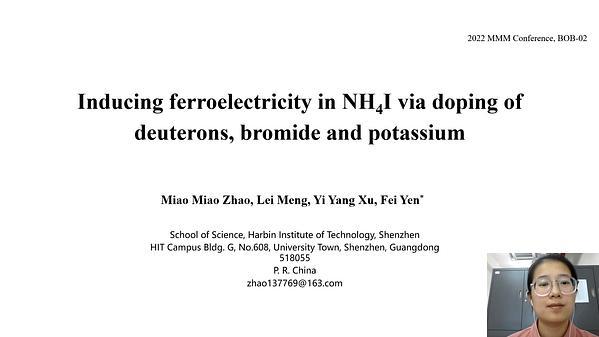Would you like to see your presentation here, made available to a global audience of researchers?
Add your own presentation or have us affordably record your next conference.
As microwave-assisted magnetic recording (MAMR) is being employed in commercial hard disk drives, technology challenges remain 1. A key one of them is the need for relatively strong ac field amplitude. Here, we present a novel scheme to substantially enhance the efficiency of the ac field. For a single domain magnetic particle of uniaxial anisotropy, the anisotropy energy is Ean=Ksin2θ where θ is the angle between the magnetic moment of the particle and the easy axis and K is the anisotropy energy density. The effective magnetic field due to this anisotropy is Han=HkcosΘ where Hk = 2K/Ms . Since the anisotropy field is a cosine function of the magnetization angle, the resonance frequency varies during a magnetization reversal. Hence, if the applied ac field frequency can match this resonance frequency variation during a magnetization reversal, the efficiency of the ac field should be significantly enhanced. Figure 1 shows the calculation for a single domain particle of Hk=30kOe. A magnetic field with a 2o angle w.r.t. the easy axis and duration of 1ns is applied opposite to the initial magnetization The ac field is a rotating perpendicular to the easy axis with a during of 1ns. The ac field frequency is either a constant (black), linearly decreases to zero, or follows the function of ω0cos(0.86t/τ) where τ=1ns. The horizontal axis is the initial ac field frequency. The ac field amplitude is set as 1% of the anisotropy field at 300 Oe. In the case of the cosine-varying frequency ac field, the switching field reduction is more than 75% Hk, at 6kOe. The substantially enhanced switching field reduction shows the efficiency gain by having ac field frequency following the resonance frequency reduction during the magnetization reversal. Figure 2 shows the switching field of a particle of Hk=25kOe and the ac field frequency is the cosine-varying case. When the ac field amplitude exceeds 350 Oe, the switching can be achieved without the reversal field applied.
References
1 J.-G. Zhu, X. Zhu, and Y. Tang, “Microwave assisted magnetic recording,” IEEE Trans. Magn., vol. 44, no. 1, pp. 125–131, Jan. 2008.
2 Akihiko Takeo, et al, "Extended Concept of MAMR and its Performance and Reliability," Paper C1, TMRC 2020, August 2020.

Fig. 1. Switching field vs the initial frequency of ac fields with the frequency being constant (black), linearly decreasing (blue), or cosine-varying (red).

Fig. 2. Switching field vs initial ac field frequency for a cosine-varying frequency rotating ac field.
